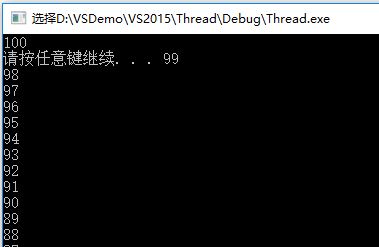C++11中引入了一个用于多线程操作的thread类
简单多线程示例:
1
2
3
4
5
6
7
8
9
10
11
12
13
14
15
16
17
18
19
20
21
22
23
24
25
26
27
28
29
30
31
32
33
34
35
36
37
| #include <iostream>
#include <thread>
#include <Windows.h>
using namespace std;
void thread01()
{
for (int i = 0; i < 5; i++)
{
cout << "Thread 01 is working !" << endl;
Sleep(100);
}
}
void thread02()
{
for (int i = 0; i < 5; i++)
{
cout << "Thread 02 is working !" << endl;
Sleep(200);
}
}
int main()
{
thread task01(thread01);
thread task02(thread02);
task01.join();
task02.join();
for (int i = 0; i < 5; i++)
{
cout << "Main thread is working !" << endl;
Sleep(200);
}
system("pause");
}
|
输出:
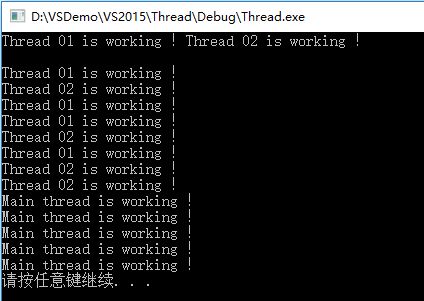
非堵塞多线程
两个子线程并行执行,join函数会阻塞主流程,所以子线程都执行完成之后才继续执行主线程。可以使用detach将子线程从主流程中分离,独立运行,不会阻塞主线程:
1
2
3
4
5
6
7
8
9
10
11
12
13
14
15
16
17
18
19
20
21
22
23
24
25
26
27
28
29
30
31
32
33
34
35
36
37
| #include <iostream>
#include <thread>
#include <Windows.h>
using namespace std;
void thread01()
{
for (int i = 0; i < 5; i++)
{
cout << "Thread 01 is working !" << endl;
Sleep(100);
}
}
void thread02()
{
for (int i = 0; i < 5; i++)
{
cout << "Thread 02 is working !" << endl;
Sleep(200);
}
}
int main()
{
thread task01(thread01);
thread task02(thread02);
task01.detach();
task02.detach();
for (int i = 0; i < 5; i++)
{
cout << "Main thread is working !" << endl;
Sleep(200);
}
system("pause");
}
|
输出:
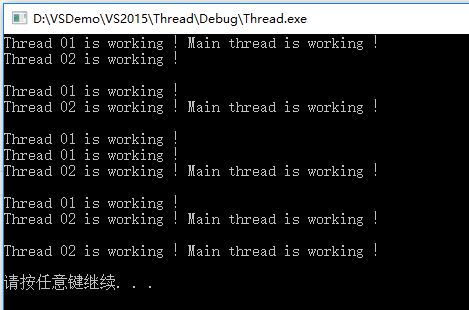
使用detach的主线程和两个子线程并行执行。
带参子线程
在绑定的时候也可以同时给带参数的线程传入参数:
1
2
3
4
5
6
7
8
9
10
11
12
13
14
15
16
17
18
19
20
21
22
23
24
25
26
27
28
29
30
31
32
33
34
35
36
37
38
| #include <iostream>
#include <thread>
#include <Windows.h>
using namespace std;
//定义带参数子线程
void thread01(int num)
{
for (int i = 0; i < num; i++)
{
cout << "Thread 01 is working !" << endl;
Sleep(100);
}
}
void thread02(int num)
{
for (int i = 0; i < num; i++)
{
cout << "Thread 02 is working !" << endl;
Sleep(200);
}
}
int main()
{
thread task01(thread01, 5); //带参数子线程
thread task02(thread02, 5);
task01.detach();
task02.detach();
for (int i = 0; i < 5; i++)
{
cout << "Main thread is working !" << endl;
Sleep(200);
}
system("pause");
}
|
输出跟上例输出一样:
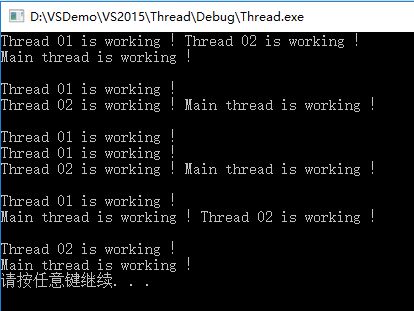
多线程数据竞争
多个线程同时对同一变量进行操作的时候,如果不对变量做一些保护处理,有可能导致处理结果异常:
1
2
3
4
5
6
7
8
9
10
11
12
13
14
15
16
17
18
19
20
21
22
23
24
25
26
27
28
29
30
31
32
33
34
35
| #include <iostream>
#include <thread>
#include <Windows.h>
using namespace std;
int totalNum = 100;
void thread01()
{
while (totalNum > 0)
{
cout << totalNum << endl;
totalNum--;
Sleep(100);
}
}
void thread02()
{
while (totalNum > 0)
{
cout << totalNum << endl;
totalNum--;
Sleep(100);
}
}
int main()
{
thread task01(thread01);
thread task02(thread02);
task01.detach();
task02.detach();
system("pause");
}
|
输出结果(部分):
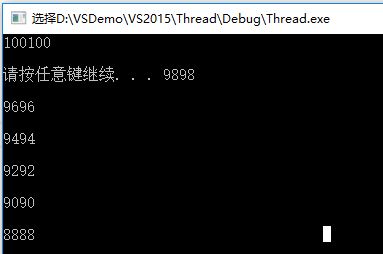
有两个问题,一是有很多变量被重复输出了,而有的变量没有被输出;二是正常情况下每个线程输出的数据后应该紧跟一个换行符,但这里大部分却是另一个线程的输出。
这是由于第一个线程对变量操作的过程中,第二个线程也对同一个变量进行各操作,导致第一个线程处理完后的输出有可能是线程二操作的结果。针对这种数据竞争的情况,可以使用线程互斥对象mutex保持数据同步。
mutex类的使用需要包含头文件mutex:
1
2
3
4
5
6
7
8
9
10
11
12
13
14
15
16
17
18
19
20
21
22
23
24
25
26
27
28
29
30
31
32
33
34
35
36
37
38
39
40
41
42
| #include <iostream>
#include <thread>
#include <Windows.h>
#include <mutex>
using namespace std;
mutex mu; //线程互斥对象
int totalNum = 100;
void thread01()
{
while (totalNum > 0)
{
mu.lock(); //同步数据锁
cout << totalNum << endl;
totalNum--;
Sleep(100);
mu.unlock(); //解除锁定
}
}
void thread02()
{
while (totalNum > 0)
{
mu.lock();
cout << totalNum << endl;
totalNum--;
Sleep(100);
mu.unlock();
}
}
int main()
{
thread task01(thread01);
thread task02(thread02);
task01.detach();
task02.detach();
system("pause");
}
|
多线程中加入mutex互斥对象之后输出正常:
